octane FORD F SERIES MOTORHOME AND COMMERCIAL CHASSIS 2007 11.G Owners Manual
[x] Cancel search | Manufacturer: FORD, Model Year: 2007, Model line: F SERIES MOTORHOME AND COMMERCIAL CHASSIS, Model: FORD F SERIES MOTORHOME AND COMMERCIAL CHASSIS 2007 11.GPages: 128, PDF Size: 1.43 MB
Page 100 of 128
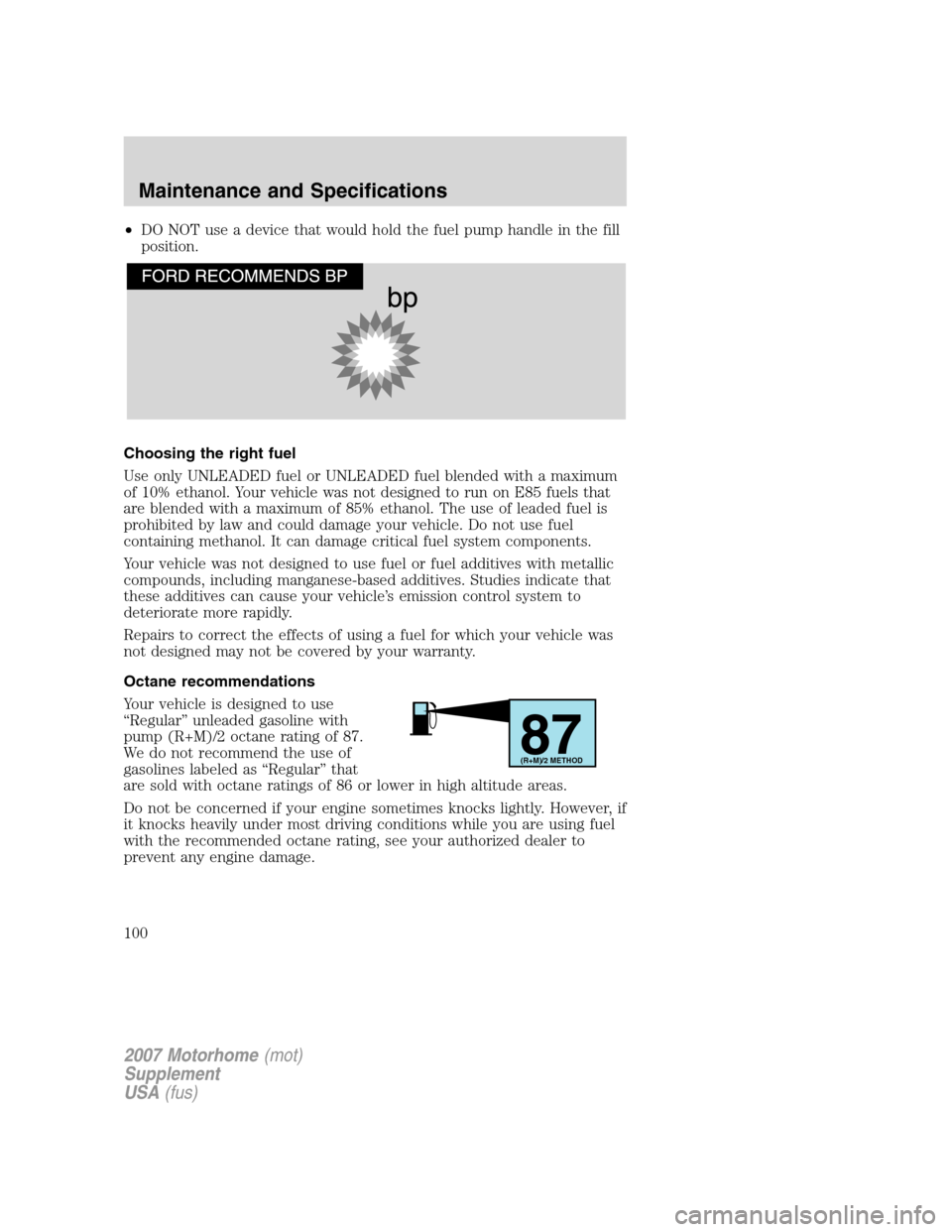
•DO NOT use a device that would hold the fuel pump handle in the fill
position.
Choosing the right fuel
Use only UNLEADED fuel or UNLEADED fuel blended with a maximum
of 10% ethanol. Your vehicle was not designed to run on E85 fuels that
are blended with a maximum of 85% ethanol. The use of leaded fuel is
prohibited by law and could damage your vehicle. Do not use fuel
containing methanol. It can damage critical fuel system components.
Your vehicle was not designed to use fuel or fuel additives with metallic
compounds, including manganese-based additives. Studies indicate that
these additives can cause your vehicle’s emission control system to
deteriorate more rapidly.
Repairs to correct the effects of using a fuel for which your vehicle was
not designed may not be covered by your warranty.
Octane recommendations
Your vehicle is designed to use
“Regular” unleaded gasoline with
pump (R+M)/2 octane rating of 87.
We do not recommend the use of
gasolines labeled as “Regular” that
are sold with octane ratings of 86 or lower in high altitude areas.
Do not be concerned if your engine sometimes knocks lightly. However, if
it knocks heavily under most driving conditions while you are using fuel
with the recommended octane rating, see your authorized dealer to
prevent any engine damage.
87(R+M)/2 METHOD
2007 Motorhome(mot)
Supplement
USA(fus)
Maintenance and Specifications
100
Page 101 of 128
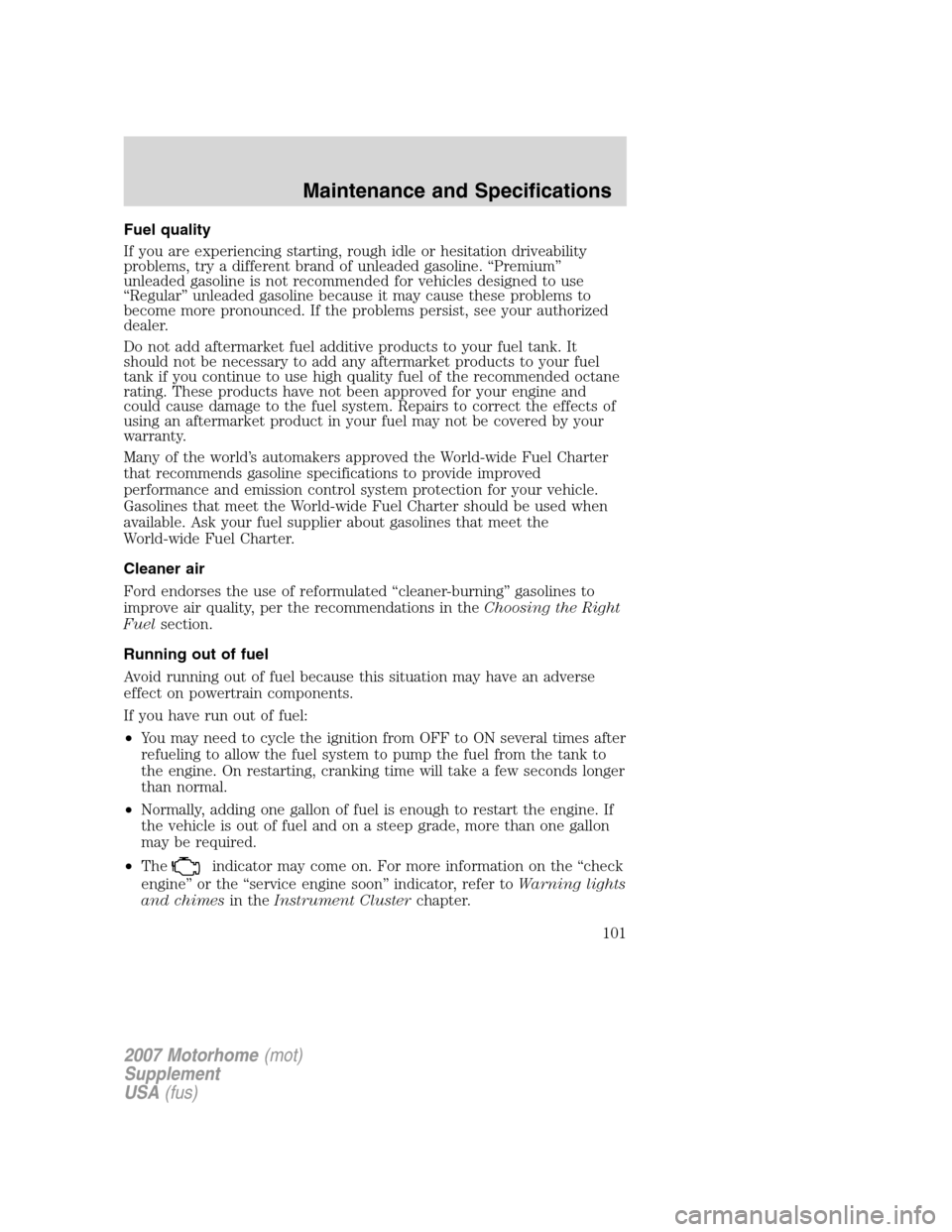
Fuel quality
If you are experiencing starting, rough idle or hesitation driveability
problems, try a different brand of unleaded gasoline. “Premium”
unleaded gasoline is not recommended for vehicles designed to use
“Regular” unleaded gasoline because it may cause these problems to
become more pronounced. If the problems persist, see your authorized
dealer.
Do not add aftermarket fuel additive products to your fuel tank. It
should not be necessary to add any aftermarket products to your fuel
tank if you continue to use high quality fuel of the recommended octane
rating. These products have not been approved for your engine and
could cause damage to the fuel system. Repairs to correct the effects of
using an aftermarket product in your fuel may not be covered by your
warranty.
Many of the world’s automakers approved the World-wide Fuel Charter
that recommends gasoline specifications to provide improved
performance and emission control system protection for your vehicle.
Gasolines that meet the World-wide Fuel Charter should be used when
available. Ask your fuel supplier about gasolines that meet the
World-wide Fuel Charter.
Cleaner air
Ford endorses the use of reformulated “cleaner-burning” gasolines to
improve air quality, per the recommendations in theChoosing the Right
Fuelsection.
Running out of fuel
Avoid running out of fuel because this situation may have an adverse
effect on powertrain components.
If you have run out of fuel:
•You may need to cycle the ignition from OFF to ON several times after
refueling to allow the fuel system to pump the fuel from the tank to
the engine. On restarting, cranking time will take a few seconds longer
than normal.
•Normally, adding one gallon of fuel is enough to restart the engine. If
the vehicle is out of fuel and on a steep grade, more than one gallon
may be required.
•The
indicator may come on. For more information on the “check
engine” or the “service engine soon” indicator, refer toWarning lights
and chimesin theInstrument Clusterchapter.
2007 Motorhome(mot)
Supplement
USA(fus)
Maintenance and Specifications
101
Page 102 of 128
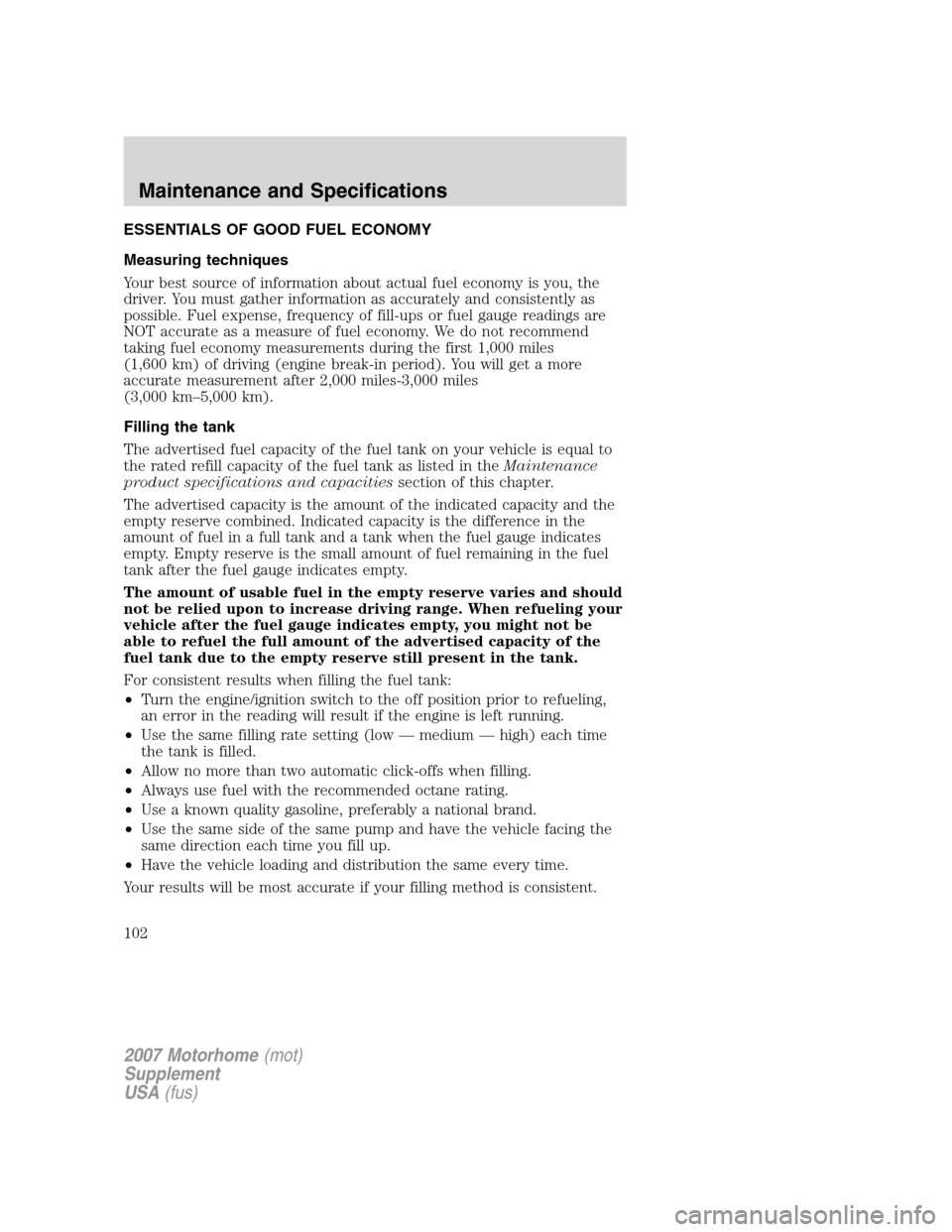
ESSENTIALS OF GOOD FUEL ECONOMY
Measuring techniques
Your best source of information about actual fuel economy is you, the
driver. You must gather information as accurately and consistently as
possible. Fuel expense, frequency of fill-ups or fuel gauge readings are
NOT accurate as a measure of fuel economy. We do not recommend
taking fuel economy measurements during the first 1,000 miles
(1,600 km) of driving (engine break-in period). You will get a more
accurate measurement after 2,000 miles-3,000 miles
(3,000 km–5,000 km).
Filling the tank
The advertised fuel capacity of the fuel tank on your vehicle is equal to
the rated refill capacity of the fuel tank as listed in theMaintenance
product specifications and capacitiessection of this chapter.
The advertised capacity is the amount of the indicated capacity and the
empty reserve combined. Indicated capacity is the difference in the
amount of fuel in a full tank and a tank when the fuel gauge indicates
empty. Empty reserve is the small amount of fuel remaining in the fuel
tank after the fuel gauge indicates empty.
The amount of usable fuel in the empty reserve varies and should
not be relied upon to increase driving range. When refueling your
vehicle after the fuel gauge indicates empty, you might not be
able to refuel the full amount of the advertised capacity of the
fuel tank due to the empty reserve still present in the tank.
For consistent results when filling the fuel tank:
•Turn the engine/ignition switch to the off position prior to refueling,
an error in the reading will result if the engine is left running.
•Use the same filling rate setting (low — medium — high) each time
the tank is filled.
•Allow no more than two automatic click-offs when filling.
•Always use fuel with the recommended octane rating.
•Use a known quality gasoline, preferably a national brand.
•Use the same side of the same pump and have the vehicle facing the
same direction each time you fill up.
•Have the vehicle loading and distribution the same every time.
Your results will be most accurate if your filling method is consistent.
2007 Motorhome(mot)
Supplement
USA(fus)
Maintenance and Specifications
102
Page 120 of 128
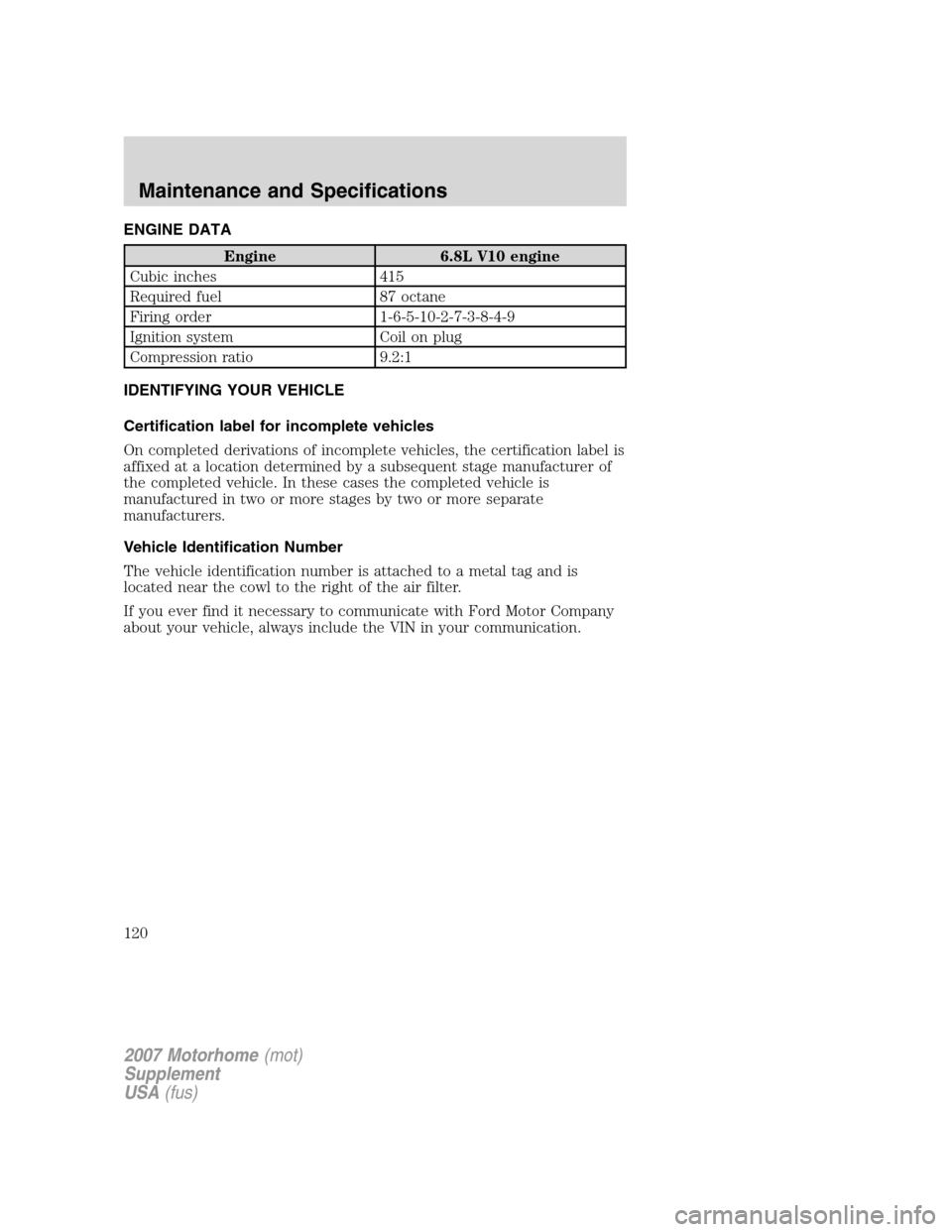
ENGINE DATA
Engine 6.8L V10 engine
Cubic inches 415
Required fuel 87 octane
Firing order 1-6-5-10-2-7-3-8-4-9
Ignition system Coil on plug
Compression ratio 9.2:1
IDENTIFYING YOUR VEHICLE
Certification label for incomplete vehicles
On completed derivations of incomplete vehicles, the certification label is
affixed at a location determined by a subsequent stage manufacturer of
the completed vehicle. In these cases the completed vehicle is
manufactured in two or more stages by two or more separate
manufacturers.
Vehicle Identification Number
The vehicle identification number is attached to a metal tag and is
located near the cowl to the right of the air filter.
If you ever find it necessary to communicate with Ford Motor Company
about your vehicle, always include the VIN in your communication.
2007 Motorhome(mot)
Supplement
USA(fus)
Maintenance and Specifications
120
Page 123 of 128
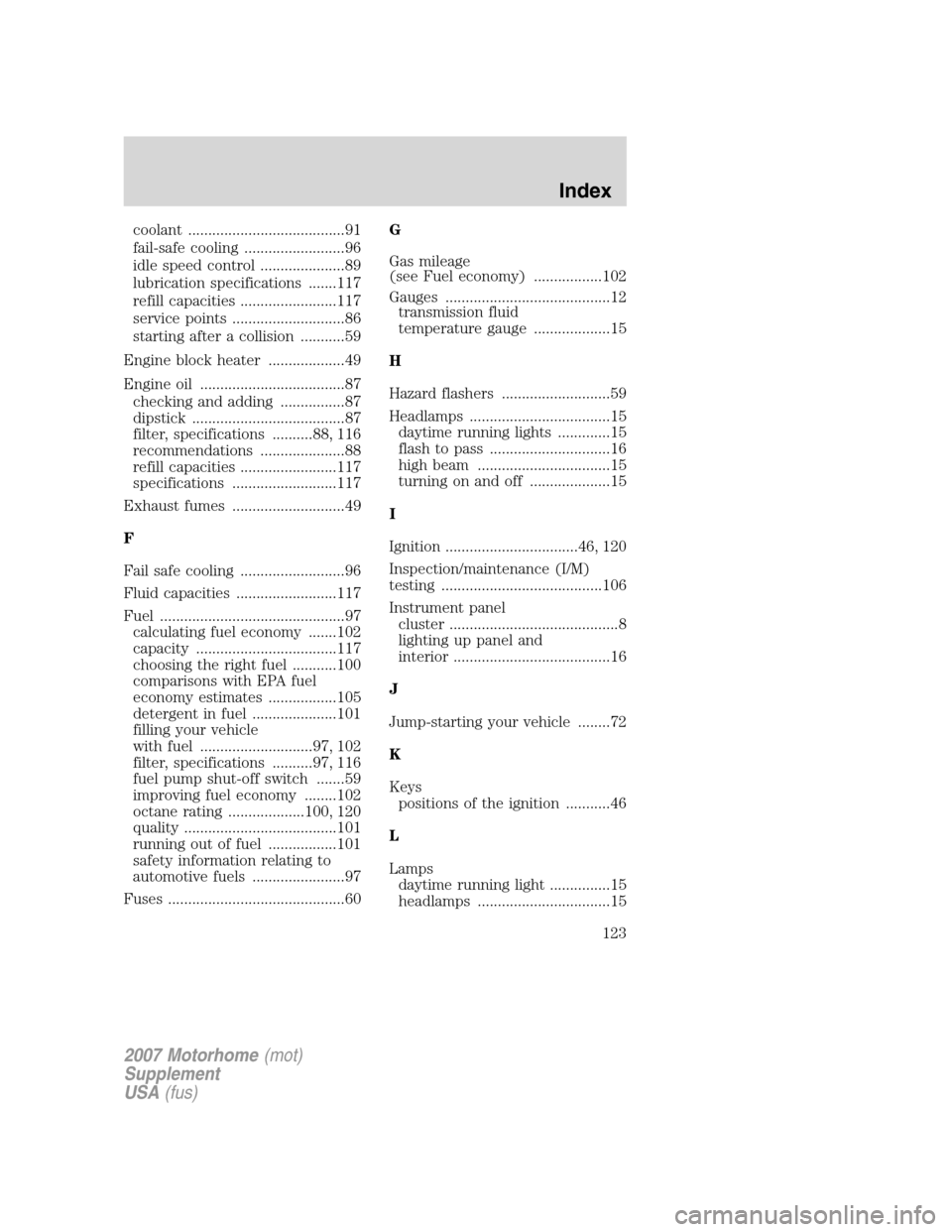
coolant .......................................91
fail-safe cooling .........................96
idle speed control .....................89
lubrication specifications .......117
refill capacities ........................117
service points ............................86
starting after a collision ...........59
Engine block heater ...................49
Engine oil ....................................87
checking and adding ................87
dipstick ......................................87
filter, specifications ..........88, 116
recommendations .....................88
refill capacities ........................117
specifications ..........................117
Exhaust fumes ............................49
F
Fail safe cooling ..........................96
Fluid capacities .........................117
Fuel ..............................................97
calculating fuel economy .......102
capacity ...................................117
choosing the right fuel ...........100
comparisons with EPA fuel
economy estimates .................105
detergent in fuel .....................101
filling your vehicle
with fuel ............................97, 102
filter, specifications ..........97, 116
fuel pump shut-off switch .......59
improving fuel economy ........102
octane rating ...................100, 120
quality ......................................101
running out of fuel .................101
safety information relating to
automotive fuels .......................97
Fuses ............................................60G
Gas mileage
(see Fuel economy) .................102
Gauges .........................................12
transmission fluid
temperature gauge ...................15
H
Hazard flashers ...........................59
Headlamps ...................................15
daytime running lights .............15
flash to pass ..............................16
high beam .................................15
turning on and off ....................15
I
Ignition .................................46, 120
Inspection/maintenance (I/M)
testing ........................................106
Instrument panel
cluster ..........................................8
lighting up panel and
interior .......................................16
J
Jump-starting your vehicle ........72
K
Keys
positions of the ignition ...........46
L
Lamps
daytime running light ...............15
headlamps .................................15
2007 Motorhome(mot)
Supplement
USA(fus)
Index
123
Page 124 of 128
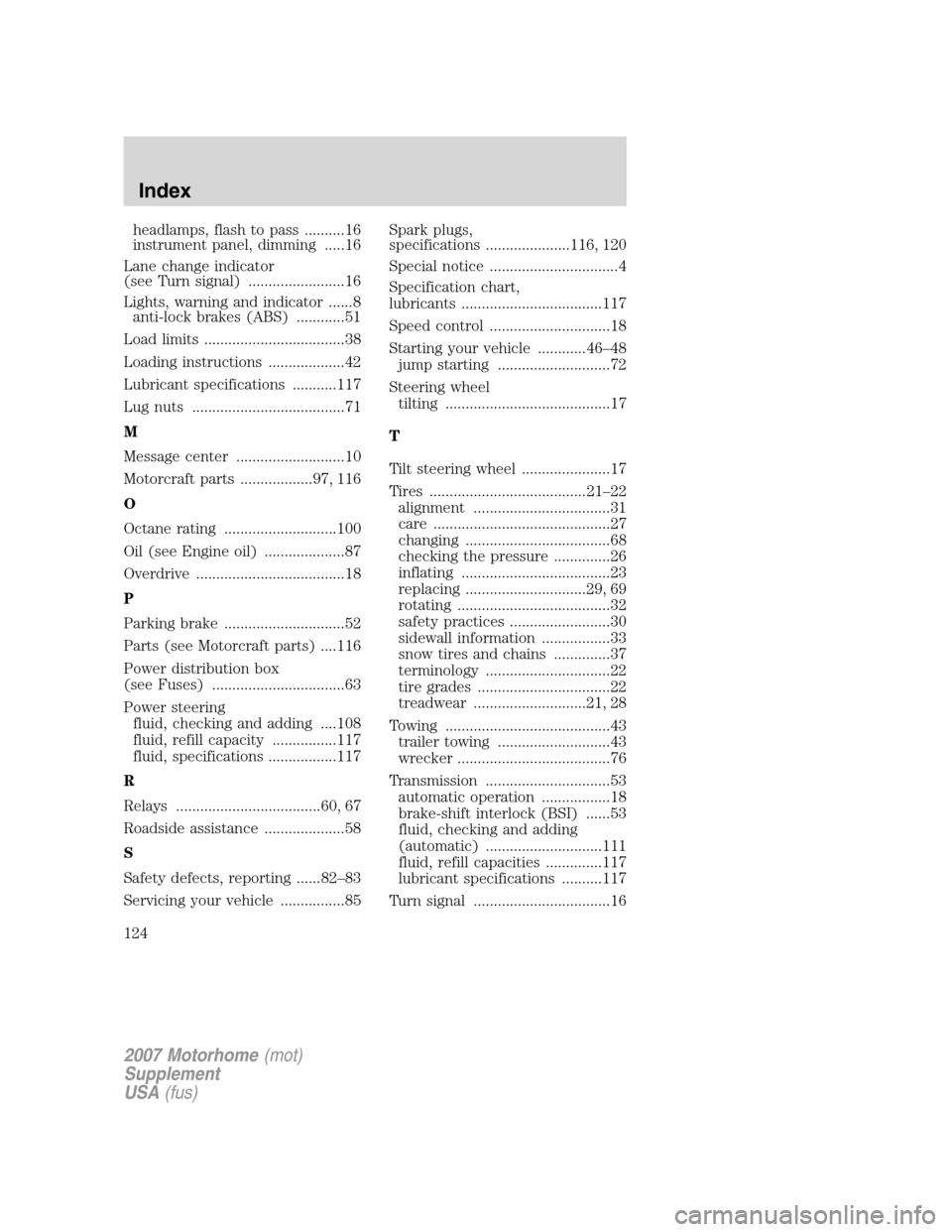
headlamps, flash to pass ..........16
instrument panel, dimming .....16
Lane change indicator
(see Turn signal) ........................16
Lights, warning and indicator ......8 anti-lock brakes (ABS) ............51
Load limits ...................................38
Loading instructions ...................42
Lubricant specifications ...........117
Lug nuts ......................................71
M
Message center ...........................10
Motorcraft parts ..................97, 116
O
Octane rating ............................100
Oil (see Engine oil) ....................87
Overdrive .....................................18
P
Parking brake ..............................52
Parts (see Motorcraft parts) ....116
Power distribution box
(see Fuses) .................................63
Power steering fluid, checking and adding ....108
fluid, refill capacity ................117
fluid, specifications .................117
R
Relays ....................................60, 67
Roadside assistance ....................58
S
Safety defects, reporting ......82–83
Servicing your vehicle ................85 Spark plugs,
specifications .....................116, 120
Special notice ................................4
Specification chart,
lubricants ...................................117
Speed control ..............................18
Starting your vehicle ............46–48
jump starting ............................72
Steering wheel tilting .........................................17
T
Tilt steering wheel ......................17
Tires .......................................21–22 alignment ..................................31
care ............................................27
changing ....................................68
checking the pressure ..............26
inflating .....................................23
replacing ..............................29, 69
rotating ......................................32
safety practices .........................30
sidewall information .................33
snow tires and chains ..............37
terminology ...............................22
tire grades .................................22
treadwear ............................21, 28
Towing .........................................43 trailer towing ............................43
wrecker ......................................76
Transmission ...............................53 automatic operation .................18
brake-shift interlock (BSI) ......53
fluid, checking and adding
(automatic) .............................111
fluid, refill capacities ..............117
lubricant specifications ..........117
Turn signal ..................................16
2007 Motorhome (mot)
Supplement
USA (fus)
Index
124